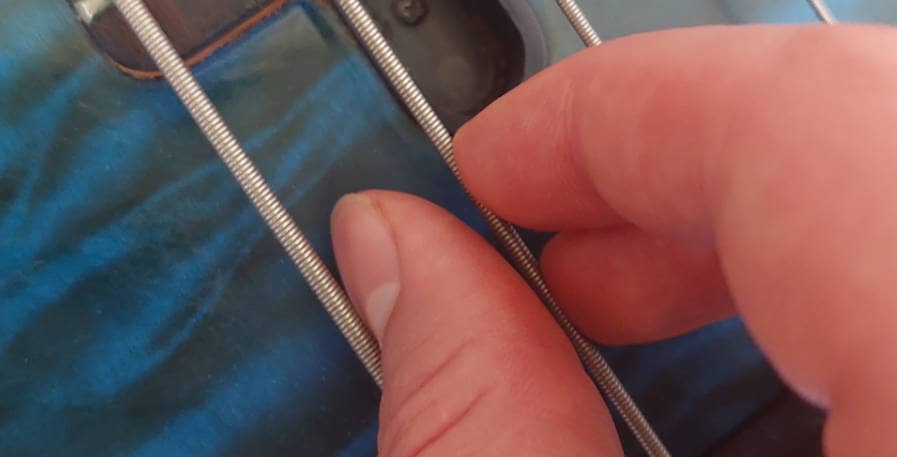If you are a bass player that’s considering the floating thumb technique, you are already on the right track.
I say this because thumb placement when playing the bass is a crucial part of your technique. Yet, it is one that is overlooked far too often.
Since there is a good bit of confusion about the floating thumb floating around, I thus decided to write this guide. This way, you`ll get a clear answer to what the technique actually entails, and whether it might be right for you.
I`ll start by clarifying what floating thumb actually means, and how it differs from the moveable anchor technique. Then, I`ll show you the pros and cons of using it.
Lastly, I`ll give you some exercises that will help you master the technique. I`ll also provide a list of bass players that use the technique so that you can draw inspiration from them.
What does floating thumb mean?
A floating thumb is used to keep strings muted when using your fingers to pluck the bass. Instead of being anchored firmly on strings or on the pickup, the thumb rests on top, or in between strings. Thus, the floating thumb technique enables you to mute strings without having to anchor your thumb.
When bassists play with a floating thumb, the thumb is kept loose and is never anchored on the strings. Rather, it is constantly moved to the deepest unplayed string to keep it muted.
The thumb is then generally kept between the string that needs to be muted and the one that is being played. Alternatively, it can be kept on top of the muted string, without being anchored to it.
Thus, this technique requires you to constantly move your thumb to wherever it is most needed. As a result, it can be somewhat hard to master when compared to other techniques. However, it carries several advantages over common ways thumb placement techniques.
To get a better idea of why let`s look at the differences between the floating thumb and the movable anchor.
Floating Thumb vs Movable Anchor
The most common way for bassists to place their thumb when playing with their fingers is to anchor it.
There are two main ways bassists tend to anchor their thumb.
The first is as a static anchor. This is when the thumb is always resting on the pickup, regardless of what string is being played. On basses with a pickup cover, bassists tend to rest the thumb on the cover itself.
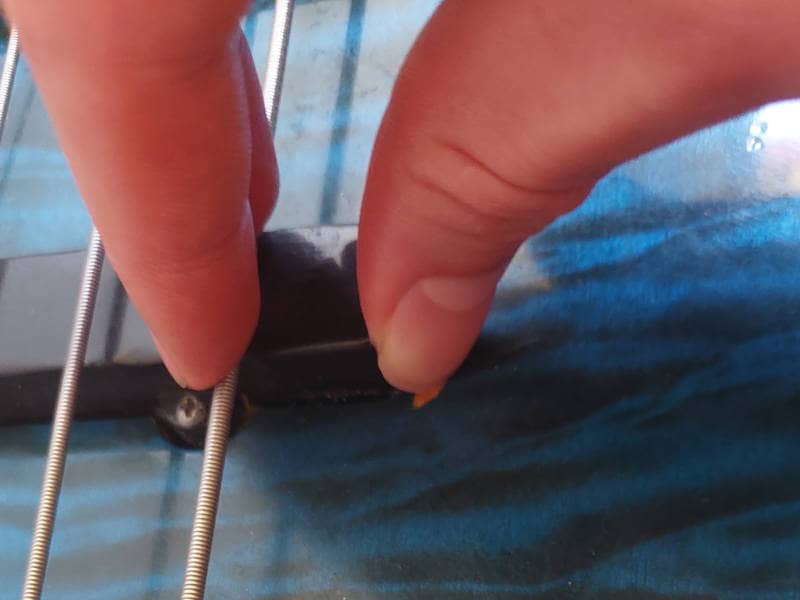
The other common option is the moving anchor. With this technique, the thumb generally rests on the deepest unplayed string. As an example, the thumb would be anchored on the E string rather than the pickup, when playing a groove on the A string.
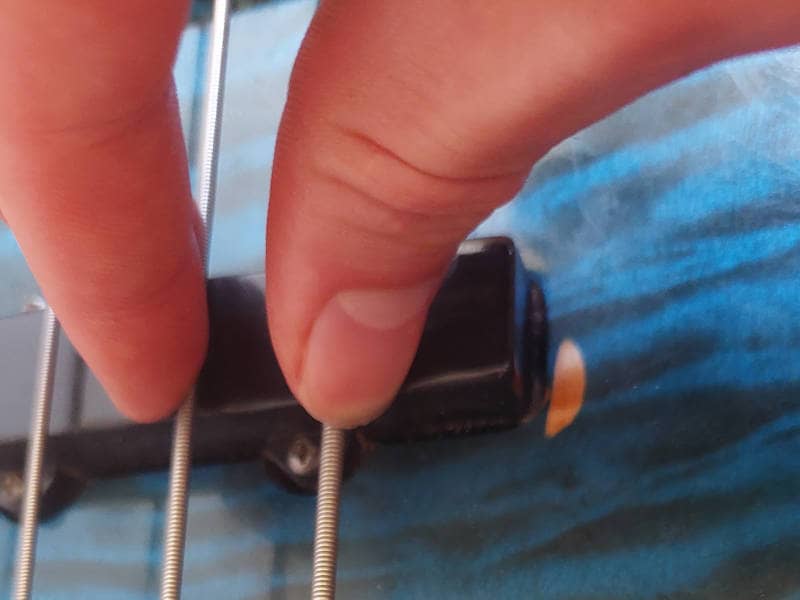
At first glance, the floating thumb can resemble a moving anchor. This has also led to some confusion about the terms among bass players and at times the terms have been used interchangeably.
However, there are some major differences between a moving anchor and a floating thumb. Namely that with a floating thumb, the thumb is not anchored on a string at all. It might still partly touch against a string, but it will not be anchored on top of it.
One way of using the floating thumb is to place it between strings. This can give you a lot of control over your plucking movements. As a result, this type of floating thumb technique can lead to better control over your tone and enable you to play faster basslines.
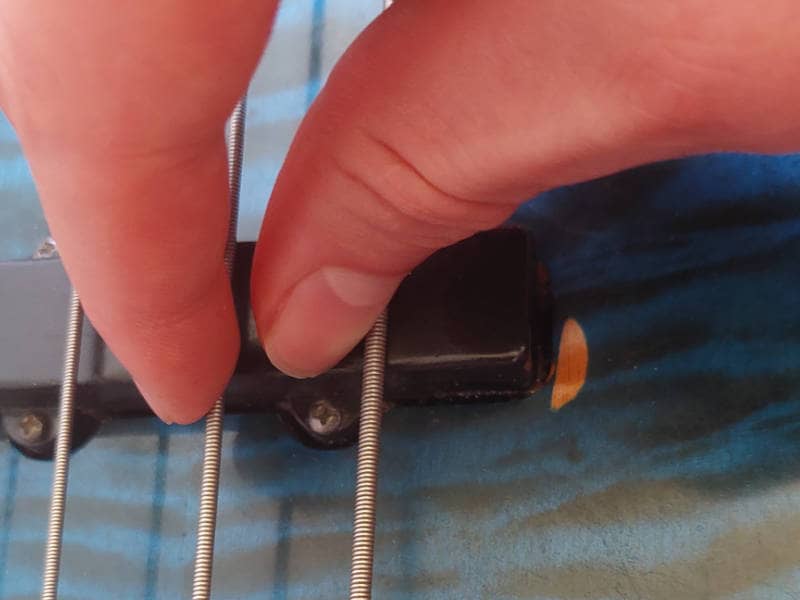
Another way to do the technique is to have the thumb float on top of the string.
This has much of the same effects as placing it between strings. Personally, I find this to sacrifice a slight bit of control over my plucking, in favor of making the thumb easier to move around. The difference is however slight, and your experience of this can vary.
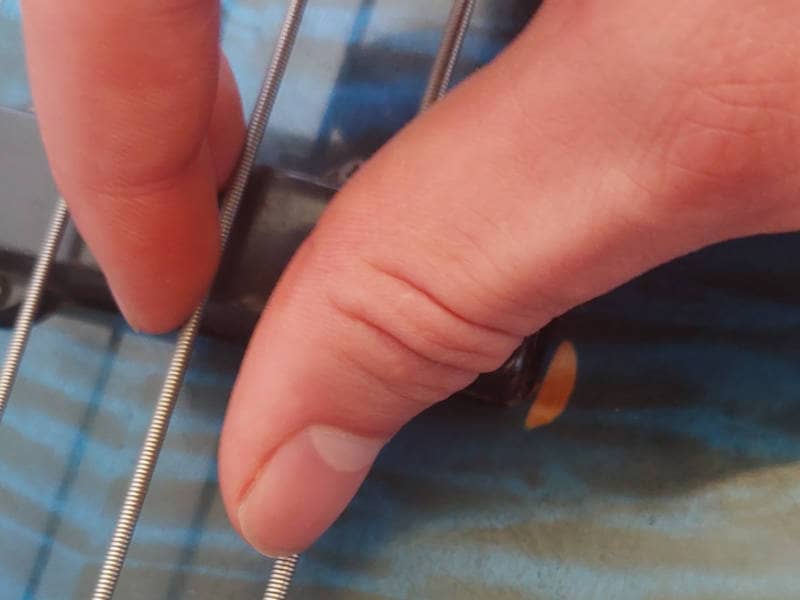
The advantage of playing with a floating thumb
While there is no single right way to place your thumb, playing with a floating thumb can carry some advantages over other alternatives.
Here are some of the key benefits of adopting this playstyle:
- Avoiding hand problems – When playing with an anchored thumb, the wrist has to be bent slightly to reach strings. This can in some cases lead to hand problems and wrist pain from playing the bass. With a floating thumb, on the other hand, it is much easier to keep the wrist straight. Therefore, it can be a more ergonomic way to play the bass, which is less likely to lead to injuries.
- It`s consistent across different basses – If you get used to anchoring the thumb on the pickup, it can be hard to transition between bass guitars. This is because the placement of the pickup can vary greatly from bass to bass. In turn, this can lead to playing feeling awkward and your muscle memory being off when trying a new one. Thus, with a floating thumb, your technique will be consistent regardless of the bass, which makes it easier to transition between instruments.
- Playing with smaller hands is easier – Playing with an anchored thumb can at times feel awkward if you have small hands. This is because you need to stretch your fingers longer to reach the lightest strings. This holds especially true on 5 and 6-string basses. However, with a floating thumb, it makes little difference what string you are playing, as you don`t have to stretch your fingers to reach them.
- More tonal control – With a floating thumb, you can be more flexible in where you choose to pluck strings. Playing right at the start of the neck, or at the bridge will produce vastly different tones. A floating thumb enables you to pick at any of these spots once you master the technique. As a result, you gain more tonal options, without having to sacrifice playability.
The disadvantages of playing with a floating thumb
As with any bass technique, there are both pros and cons to playing with a floating thumb as well.
While I have played using this technique quite a bit in the past, I gravitated towards playing with a moving anchor many years ago. While that mostly just came down to preference, here are some reasons you might not elect to play with a floating thumb:
- It`s harder to master – Developing a fluid floating thumb technique will take time. Playing with an anchored thumb works well for most bass players, and will not require the same amount of practice to master. Thus, you can spend this time focusing on other areas of your playing, which will ultimately speed up your progress as a bassist.
- Producing an aggressive tone is harder – If you are looking for an aggressive Geddy Lee-type bass tone, playing with a floating thumb might not be right for you. This is because you will generally have little space between your fingers and thumb. The result of this is that it becomes harder to play the strings with a strong attack, as you simply won`t have the space to do so.
- It is harder to control your playing – Playing with a floating thumb requires more precision and control over your plucking hand. Producing a consistent tone can thus be harder with a floating thumb. Furthermore, as you will generally be playing lighter with a floating thumb, your amp will also have to be turned up to compensate for this. As a result, unwanted changes in your attack become more noticeable, which will sound more offputting when your amp is turned up.
Learning to play bass with a floating thumb
Once you understand how the floating thumb works, you can practice it when playing any bassline. However, in the beginning, it can be beneficial to do some exercises that focus specifically on developing your floating thumb technique.
Thus, here are some exercises I made that focus on gradually building a solid floating thumb technique. Start with exercise 1, and then gradually make your way down as it becomes comfortable to play with a floating thumb.

If you find yourself stuck on exercise 1 for a single practice session, you are most likely doing things the right way. Developing control of this new technique takes time. Thus, focusing on nailing down the basics before progressing is the best thing you can do for your long-term progression.
Once you feel comfortable though, move on to exercise 2 and 3:


As you move on to exercise 4, I recommend slowing down a bit. This is because you will be switching strings between every note, which will be more challenging. As you can get comfortable playing the exercise at a slower pace, you can elect to speed it up.

The above 4 exercises will be enough to develop a decent amount of control over the floating thumb technique. If you are looking to challenge yourself a bit more, here are 2 more exercises that require more control of your thumb:


Mastering all of the above exercises the first time you try playing with a floating thumb is a tall order.
Thus, I recommend coming back to them and progressing gradually, whenever you want to focus on developing your technique. Alternatively, try playing some of these beginner-friendly bass exercises with a floating thumb.
Bassists who play with a floating thumb
A great way to get a good grasp of how to properly play with a floating thumb is to emulate other bass players.
Thus, I made a list of some of the greats that have mastered this technique.
Keep in mind though, that they should serve as a source of inspiration, rather than a guideline. You will find that these bassists still move their thumbs in different ways, without any of them being more correct than another.
Thus, any one of them might have a technique that works perfectly for you. In other cases, you might only want to emulate parts of their technique or even none at all. You will notice what works for you quickly, simply by feeling how natural their technique feels to you.
| Bassists that utilize the floating thumb technique: | Band: | Genres: |
| Alphonso Johnson | Wheater Report, various session work | Jazz, Rock |
| Steve Harris | Iron Maiden | Metal |
| Todd Johnson | Ron Escheté Trio | Jazz |
| Gary Wills | Tribal Tech, various projects | Jazz |
| John Myung | Dream Theater | Progressive Metal |
| Alain Caron | UZEB, Le Band | Jazz |
Conclusion
Playing bass with a floating thumb is not something you can learn in a day. However, those who commit to mastering the technique, can in the long term benefit greatly from spending the time needed to master it.
It requires precision, control, and flexibility. With that, it can also give you precise control over your tone, both in how you pluck the strings and where you decide to pluck them. It can also prevent you from developing hand problems, and be more beneficial for bassists with small hands.
On the other hand, it’s more challenging to pluck strings with a strong attack using the floating thumb. Thus, it is not ideal if you are looking for an aggressive rock or punk tone. It is also less forgiving if you pluck strings too softly or too strong, as you will generally turn up your amplifier to compensate for the lower volume.
Thus, while anyone can learn to play this way, the floating thumb is somewhat of a virtuoso technique. It will require more upfront practice to master, but it can elevate your bass playing to new heights once you do.

